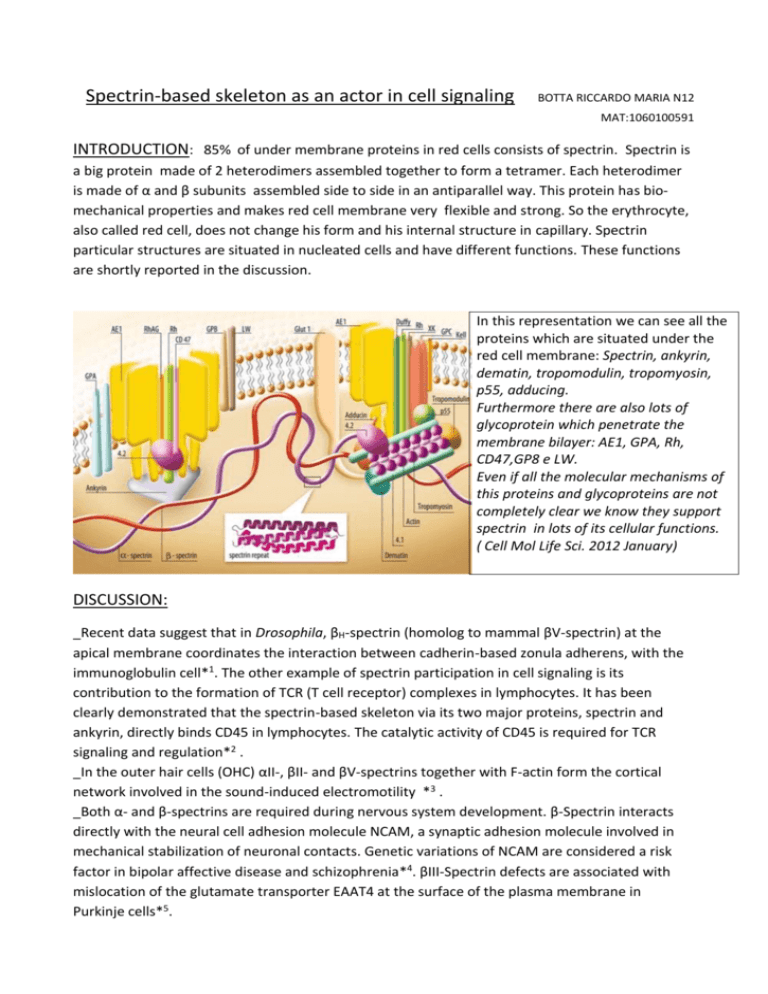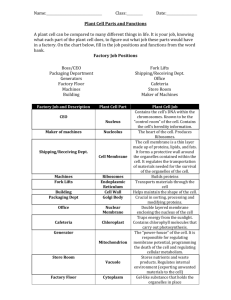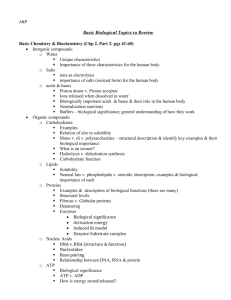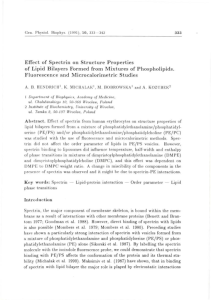Spectrin-based skeleton as an actor in cell signaling
advertisement

Spectrin-based skeleton as an actor in cell signaling BOTTA RICCARDO MARIA N12 MAT:1060100591 INTRODUCTION: 85% of under membrane proteins in red cells consists of spectrin. Spectrin is a big protein made of 2 heterodimers assembled together to form a tetramer. Each heterodimer is made of α and β subunits assembled side to side in an antiparallel way. This protein has biomechanical properties and makes red cell membrane very flexible and strong. So the erythrocyte, also called red cell, does not change his form and his internal structure in capillary. Spectrin particular structures are situated in nucleated cells and have different functions. These functions are shortly reported in the discussion. In this representation we can see all the proteins which are situated under the red cell membrane: Spectrin, ankyrin, dematin, tropomodulin, tropomyosin, p55, adducing. Furthermore there are also lots of glycoprotein which penetrate the membrane bilayer: AE1, GPA, Rh, CD47,GP8 e LW. Even if all the molecular mechanisms of this proteins and glycoproteins are not completely clear we know they support spectrin in lots of its cellular functions. ( Cell Mol Life Sci. 2012 January) DISCUSSION: _Recent data suggest that in Drosophila, βH-spectrin (homolog to mammal βV-spectrin) at the apical membrane coordinates the interaction between cadherin-based zonula adherens, with the immunoglobulin cell*1. The other example of spectrin participation in cell signaling is its contribution to the formation of TCR (T cell receptor) complexes in lymphocytes. It has been clearly demonstrated that the spectrin-based skeleton via its two major proteins, spectrin and ankyrin, directly binds CD45 in lymphocytes. The catalytic activity of CD45 is required for TCR signaling and regulation*2 . _In the outer hair cells (OHC) αII-, βII- and βV-spectrins together with F-actin form the cortical network involved in the sound-induced electromotility *3 . _Both α- and β-spectrins are required during nervous system development. β-Spectrin interacts directly with the neural cell adhesion molecule NCAM, a synaptic adhesion molecule involved in mechanical stabilization of neuronal contacts. Genetic variations of NCAM are considered a risk factor in bipolar affective disease and schizophrenia*4. βIII-Spectrin defects are associated with mislocation of the glutamate transporter EAAT4 at the surface of the plasma membrane in Purkinje cells*5. _Other studies suggest the participation of spectrin in cell cycle regulation. It is also noteworthy that in a mouse model, downregulation of expression of ELF, an isoform of βII-spectrin, confers susceptibility to tumorigenesis. Mice affected by this problem have lots of cancers ( BeckwithWiedemann syndrome)*6. Furthermore, in αII-spectrin-depleted melanoma cells, increased expression of p21 (an inhibitor of cyclin-dependent kinase) was observed, which was associated with cell cycle arrest in the G1 phase*7. Besides αII-spectrin is involved in maintaining chromosomal stability*8 . _Spectrin via its SH3 domain interacts with two members of the Ena/VASP (enabled/vasodilatorstimulated phosphoprotein) family. Ena/VASP proteins are found in focal contacts, cell-cell contacts and highly dynamic membrane regions such as lamellipodia. These proteins appear to regulate adhesion and to control actin dynamics. Proteins of the Ena/VASP family are essential for actin remodeling upon T cell activation, formation and extensions of lamellipodia *9. _βIII-Spectrin is present in the Golgi and vesicle membranes , and binds to the dynactin subunit ARP1, suggesting a possible role in transport. Arp 1 is a nucleation centre for actine filaments*10 _Spectrine destabilization and proteolysis can be induced by calcium/calmodulin *11and phosphorylation*12 . In red cells , for example, spectrine phosphorylation makes cell membrane much less elastic. CONCLUSION: Spectrin is not only situated in red cells but also in lots of nucleated cells. It has lots of functions , as well as the structural ones: adhesion and spreading, signaling in lymphocytes, cellular cycle, tumorigenesis, cell internal movement , nerve impulses conduction. REFERENCES: “Spectrin-based skeleton as an actor in cell signaling” by B. Machnicka, R. Grochowalska, D. M. Bogusławska, A. F. Sikorski, and M. C. Lecomte. Published on “Cell Mol. Life Sci.” in 2012 January INTERNAL REFERENCES: *1 Lee HG, Zarnescu DC, MacIver B, Thomas GH. The cell adhesion molecule Roughest depends on beta(Heavy)-spectrin during eye morphogenesis in Drosophila. J Cell Sci. 2010;123:277–285 *. 2 Iida N, Lokeshwar VB, Bourguignon LY. Mapping the fodrin binding domain in CD45, a leukocyte membrane-associated tyrosine phosphatase. J Biol Chem. 1994;269:28576–28583 *3 Legendre K, Safieddine S, Kussel-Andermann P, Petit C, El-Amraoui A. alphaII-betaV spectrin bridges the plasma membrane and cortical lattice in the lateral wall of the auditory outer hair cells. J Cell Sci. 2008;121:3347–3356 *4Ramser EM, Buck F, Schachner M, Tilling T. Binding of alphaII spectrin to 14–3-3beta is involved in NCAM-dependent neurite outgrowth. Mol Cell Neurosci. 2010;45:66–74. *5Perkins EM, Clarkson YL, Sabatier N, Longhurst DM, Millward CP, et al. Loss of beta-III spectrin leads to Purkinje cell dysfunction recapitulating the behavior and neuropathology of spinocerebellar ataxia type 5 in humans. J Neurosci. 2010;30:4857–4867 *6 Komada M, Soriano P. [Beta]IV-spectrin regulates sodium channel clustering through ankyrin-G at axon initial segments and nodes of Ranvier: 2002;156:337–348 *7Kim SS, Shetty K, Katuri V, Kitisin K, Baek HJ, et al. TGF-beta signaling pathway inactivation and cell cycle deregulation in the development of gastric cancer: role of the beta-spectrin, ELF. Biochem Biophys Res Commun. 2006;344:1216–1223. *8Metral S, Machnicka B, Bigot S, Colin Y, Dhermy D, et al. AlphaII-spectrin is critical for cell adhesion and cell cycle. J Biol Chem. 2009;284:2409–2418 *9 Benz PM, Blume C, Moebius J, Oschatz C, Schuh K, et al. Cytoskeleton assembly at endothelial cell-cell contacts is regulated by alphaII-spectrin-VASP complexes J Cell Biol. 2008;180:205–219 *10Holleran EA, Ligon LA, Tokito M, Stankewich MC, Morrow JS, et al. beta III spectrin binds to the Arp1 subunit of dynactin. J Biol Chem. 2001;276:36598–36605 *11Manno S, Takakuwa Y, Nagao K, Mohandas N. Modulation of erythrocyte membrane mechanical function by beta-spectrin phosphorylation and dephosphorylation. J Biol Chem. 1995;270:5659–5665 *12 Hund TJ, Koval OM, Li J, Wright PJ, Qian L, et al. A beta(IV)-spectrin/CaMKII signaling complex is essential for membrane excitability in mice. J Clin Invest. 2010;120:3508–3519











